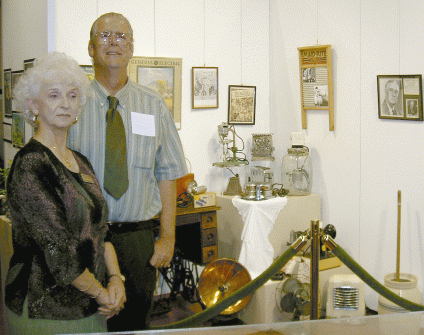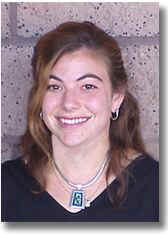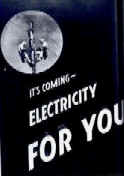|

|
Over 50 years of rural
electrification!
|
I had seen first-hand the grim drudgery and grind which had been
the common lot of eight generations of American farm women. I had seen
the tallow candle in my own home, followed by the coal-oil lamp. I knew
what it was to take care of the farm chores by the flickering, undependable light of the lantern in the mud and cold rains of the fall,
and the snow and icy winds of winter.
I had seen the cities gradually acquire a night as light as day.
I could close my eyes and recall the innumerable scenes of the
harvest and the unending punishing tasks performed by hundreds of
thousands of women, growing old prematurely; dying before their time;
conscious of the great gap between their lives and the lives of those
whom the accident of birth or choice placed in the towns and cities.
Why shouldn't I have been interested in the emancipation of
hundreds of thousands of farm women?
— Former U.S. Sen. George W, Norris of Nebraska,
co-sponsor of the Rural Electrification Act, in The Next Greatest
Thing.
The National Rural Electric Cooperative Association, the
national power co-op trade association based in Washington, D.C.,
published The Next Greatest Tiling, a history of the Rural
Electrification Administration, in 1984.
The book includes stunning photographs taken by artists hired by
the REA and the Farm Security Administration to document the hardships
faced by rural Americans and the electrification of the
countryside in the late 1930s and early 1940s.
|
|
SMECC UPDATE - Ed Sharpe Director and Lead
Archivist for SMECC
Historic
Sahuaro Ranch, in Glendale Arizona, offers the highlight of the
2004-2005 season with the historical exhibit, "Rural
Electrification."
The Southwest Museum of Engineering, Communications and Computation
(SMECC), located in Glendale Arizona, is proud to collaborate on
this display by providing information, pictures, signs and example
of appliances from the pre-electric and electrified era.
SMECC Director, Ed Sharpe's interest in REA stemmed from a personal
interest to learn about one of FDR's three letter programs
whose coverage was lacking during his high school American history
class. He wanted to learn as much as he could!
"We had a small high density display of artifacts at the
museum" Sharpe said. "We saw this exhibition as a dynamic
example of two museums partnering to produce a large display with great
depth" He continues, " Kudos to Carole De Cosmo at Historic
Sahuaro Ranch Museum and her crew, the presentation of their material
and our material was blended together in an intellectual and artistic
manner."
When asked why a display on REA, Sharpe replied, " You can learn
about power distribution in cities from any of the major power
producers." He continued "This was a chance to expose city
folks to their rural cousin's quest for electrification and betterment
of life, while providing visitors from outside the city a chance
to reminisce about their gaining of power and technology."
Sharpe continues to acquire more books, artifacts and paperwork related
to REA, and also things related to all forms of engineering,
communications and computation.
This informative and entertaining exhibit tells how electricity
dramatically changed the methods of farming and "Rural
Electrification" explains who was responsible for bringing
electrical power, what circumstances made it possible and feasible, when
it happened, and how electric power was generated and transmitted in the
past.
The fact that the Salt River Valley was electrified before the REA and
the rest of rural America is unknown to most Valley residents. The
farmers mortgaged their land to bring water (and its byproduct,
electricity) to the Valley. This display offers an education on Arizona
history and also a look at what was happening in other farming
communities in the United States through Rural Electric Cooperatives.
Electricity made the farm family's live a more pleasant existence with
the most profound effect on the farm wife. Before electricity the farm
wife had to pump the water by hand, heat with coal and wood, wash all
the clothes on a scrub board and tub, air dry the clothes and then iron
them with irons heated by coal or wood stoves. After an exhausting
day of all this and other work the poor lady would then read by
the substandard light provided by candlelight or kerosene lamp.
The rest of the family that was out working the operational
aspects of the farm enjoyed the labor and time saving benefits offered
by electricity.
Milking the cows was faster and more efficient.
Pumping water electrically was a wonder!
Having good lighting added to productivity and safety.
Electric tools made construction and repair on the farm move at a faster
pace!
Radios and later televisions could be just plugged into the
wall.. gone were the bulky batteries and wind chargers.
But... to learn all the benefits, you need to take in this
wonderful exhibition!
Rural Electrification brought farm families together as they formed
cooperatives to obtain electric power. Some of the side
activities included REA cook books, picnics, work parties, pot lucks and
more. REA brought people together and made life better!
Below: Rural Electrification Exhibit opening night.
Carole De Cosmo, Director of Historic Sahuaro Ranch Museum
and Ed Sharpe Director and Lead Archivist of SMECC.
Pictured are some of the 3 dimensional and pictorial REA
artifacts the SMECC lent for the exhibition.

Where to see it!
Historic Sahuaro Ranch is at 9802 N. 59th Ave., (59th and Mountain View)
in Glendale and is open to the public. Website http://www.sahuaroranch.org/
The grounds - populated with peacocks, chickens, rabbits and graced with
a rose garden - are open from dawn to dusk each day. Hours for the
Galleries, Main House Tours and Museum Store are from 10 a.m. to 4 p.m.
Wednesdays through Saturdays.
Group tours and educational tours can be arranged by calling the Sahuaro
Ranch Foundation office at (623) 930-4200. Admission to the grounds and
gallery is free and open to the public.
The Southwest Museum of Engineering, Communications and Computation
(SMECC) can be reached at 623-435-1522 for further information on SMECC
please visit http://www.smecc.org
Thanks Ed Sharpe, Archivist for SMECC - - See the Museum's
Web Site at www.smecc.org
We are always looking for items to add to the museum's display and ref.
library - please advise if you have anything we can use.
Coury House / SMECC
5802 W. Palmaire Ave.
Phone 623-435-1522
Glendale Az 85301 USA
|



